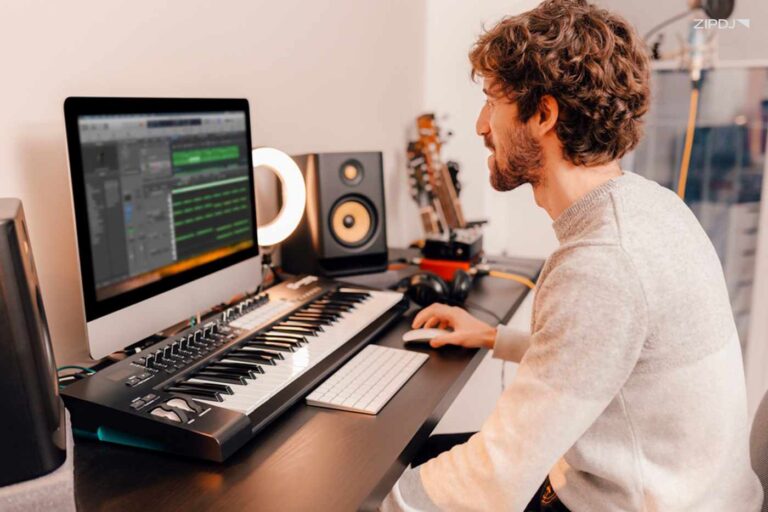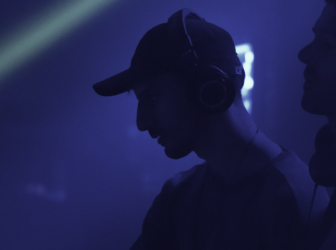The 10 Best DJ Software For Mac In 2025

DJs who are invested in Apple’s ecosystem have plenty of options when it comes to robust software for professional mixing.
The best DJ software for Mac caters to all budgets, ranging from free smartphone applications to professional DJ software with cutting-edge AI features.
Continue reading for a breakdown of the essential DJ software for Mac, exploring features, pricing options, and pros and cons.

The 10 Best DJ Software For Mac In 2025
Whether you’re a seasoned DJ or an amateur enthusiast, there’s a software option for Apple’s Mac that delivers the features you need.
Here’s an overview of the best free DJ software and paid alternatives for mixing music, both with basic and advanced features.
10. Cross DJ
Cross DJ covers the basics for beginners on Mac who need a free option.
It features a streamlined user interface that’s highly approachable, with each channel displaying important information for mixing.
The volume and cross faders are responsive, and the compatible digital music files cover everything DJs need to play sets.
If you upgrade from the free version to the paid alternative, the DJ software comes with enhanced tools, such as Snap, Slip, and Quantize.
Pros:
- Impressive options on the free version
- Simple user interface for beginners
- Compatible with iTunes music library
- Small file size and easy installation
Cons:
- Some features are locked to the paid version
- Limited tools for experienced DJs
Bottom Line:
If you’re a beginner DJ looking to experiment with basic mixing tools and learn the ropes, Cross DJ is an excellent entry point.
While it lacks the DJ production features of more comprehensive software, it’s fun to use and record mixes with various transitions.
Read testimonials from ZIPDJ members.
9. Mixxx
Another free DJ software option for newcomers is Mixxx, an open-source application with impressive mixing features.
The latest 2.0 version has enjoyed serious polish, with a refreshed user interface and additional tools to help with the DJing process.
DJs can mix on up to four decks, use FX chaining, work with RGB waveforms, and apply harmonic mixing tools based on the circle of fifths.
The visualization of the mixing process is vibrant, with plenty of effects and chains to explore as you gain confidence in your skills.
Pros:
- Completely free to use
- Four-deck mixing with master sync
- Impressive library management system
- Powerful selection of effects
Cons:
- Issues with interface resizing
- MIDI mapping is lacking
Bottom Line:
Like Cross DJ, Mixxx aims squarely at DJs on a tight budget but still delivers a surprisingly broad selection of DJing features.
Aside from issues with MIDI mapping, the workflow is generally intuitive, and the skills learned here can be easily adapted to fully-fledged paid software.
8. Ableton Live
Ableton Live is an outlier among DJ software on Mac devices. It serves primarily as a music production application for compositions.
While it’s excellent for making original tracks and DJ drops, Ableton Live also holds a significant role in any DJ’s workflow when they perform live.
When paired with the right controller, tracks, samples, and effects can be easily triggered at the touch of a button.
Likewise, tracks can be broken into sections for “megaset” performances, functioning similarly to how stem separation works on other software.
There are also impressive looping options that work well with MIDI controllers, and adding Max4Live elevates mixing in key to new heights.
Pros:
- Impressive options for creative freedom
- Robust live performance integration for producers
- Ideal for DJ producers creating original tracks
- Comprehensive MIDI controller compatibility
Cons:
- Not traditional DJ software
- Steep learning curve
Bottom Line:
Ableton Live’s production tools and automation make it a hybrid DJ software, even if it lacks some of the core tools that dedicated applications offer.
Anyone considering becoming a DJ producer will find that this software seamlessly fits into their workflow, blending new music with loops, effects, and other elements.
With regular new updates, Ableton Live fully deserves its status as one of the go-to music applications for DJ sets that incorporate live elements.
7. Engine DJ
Whether performing EDM music or underground techno, Engine DJ delivers access to millions of tracks and digital streaming services.
The DJ software can quickly isolate stems from tracks, separating bass, vocals, and other elements into compatible hardware.
Its DJ collection management tools are particularly robust, aiding track preparation on desktop or laptop devices with an efficient workflow.
Engine DJ also works with several streaming platforms, including TIDAL, Amazon Music, Beaport, and Apple Music.
The biggest draw is the automatic syncing with Philips Hue Smart Lights, transforming the music into an impressive visual display.
Pros:
- Exceptional library organization tools
- Instant drops and build-ups with Touch FX
- Built-in standalone sampler
- M1 and Big Sur Apple compatibility
Cons:
- Looping could be improved
- Not compatible with all controllers
Bottom Line:
Engine DJ’s in-depth tools and impressive lighting system make it an excellent option for DJs who have invested in compatible hardware from Denon and Numark.
The developers continue to add new features and fix issues, making it a solid, future-proof option for Mac users looking to enhance their skill level.
6. Virtual DJ
One of the most popular DJ software programs globally, Virtual DJ has evolved considerably since its first release, with many impressive new features.
These features begin with basic mixing tools and expand to higher-level processes for DJ stems and endless customization options.
Its one-size-fits-all approach to hardware and streamlined user interface also enhances its appeal to a broader range of DJs.
Advanced EQ modes, combined with robust effects, make Virtual DJ a highly versatile application for more experienced DJs.
Full support is also available for Beatport LINK and streaming platforms such as SoundCloud, Beatsource, and Deezer.
Pros:
- Easy-to-use features
- Free version available for newcomers
- Exceptionally implemented stem separation
- Plenty of built-in tutorials
Cons:
- Some audio artefacts diminish sound quality
- Upgrade required to access all features
Bottom Line:
A long-standing favorite among many DJs, Virtual DJ has evolved rapidly to become a leading player in the industry.
While its AI stem separation can occasionally have issues, live remixing options are a dream for DJs who are experimenting with advanced methods.

5. Rekordbox
Created by Pioneer and designed to be compatible with the brand’s range of controllers, Rekordbox also operates independently from hardware.
The interface requires some adjustment and can initially feel overloaded with information, but once mastered, it’s easy to use.
Comprehensive beatgridding assists with mixing, with a handy metronome for newcomers to help with beat matching.
Rekordbox truly shines in the effects; all of them sound excellent and can be triggered through the on-screen pads.
Compatibility with Apple Music’s archives and optimized performance for Mac hardware make Rekordbox a solid choice for clubbing DJs.
Pros:
- Club standard platform for professional DJs
- Impressive cloud library features
- Full video playback support
- Music and light syncing options
Cons:
- Real-time stems could be improved
- Relatively steep learning curve
Bottom Line:
A regular fixture in the world’s leading venues, Rekordbox has become a worthy competitor to Serato and Traktor in the DJ scene.
If you’re a Mac owner with Pioneer controllers in your equipment list, using Rekordbox will make life easier behind the decks.
Recommended reading: Discover the best mashup makers in 2025.
4. DJ.Studio
Another excellent option for DJs interested in learning music production is DJ.Studio, which is packed with mixing features.
There’s an Ableton Live project export option for more in-depth production, while the artificial intelligence DJ tools are a pleasure to use.
Aimed at the professional user, it offers versatile filters, effects, and EQ options. It also allows DJs to mix music using YouTube.
With new features regularly added that enhance the user experience, DJ.Studio is one of the best AI DJ software options on the market.
Pros:
- AI-assisted timeline editor
- Impressive tools for creating playlists
- Robust file format and cross-platform export options
- Interoperability with Beatport, Apple Music, and more
Cons:
- Not geared toward live DJ performances
- Workflow can take a while to grasp
Bottom Line:
DJ. Studio takes a studio-focused approach to recording DJ sets, allowing users to perfect their edits and transitions before releasing them online.
It’s a highly capable application for creating DJ mixtapes that showcase your DJing skills.
3. DJay Pro AI
Compatible with all Mac devices, DJay Pro AI is frequently ranked among the best DJ software for Apple users on desktop and portable devices.
It has the same refined visual style as Mac’s leading tools, is compatible with an extensive gear list, and includes a digital vinyl system feature.
Mac, iPhone, or iPad users can install it on multiple devices with a subscription, each offering a customized software view for ease of use.
The neural mix tool also delivers real-time stem separation aligned with Reloop controllers for quick mapping.
Pros:
- Well-organized user interface
- Excellent audio quality
- Compatible with MacBook Pro TouchBar
- A free-to-use version is available to try
Cons:
- Additional expenditure for the Extra FX mode
- Lacks cross-device playlist syncing
Bottom Line:
DJay Pro AI has become one of the go-to applications for Mac owners, particularly those interested in mixing on portable devices.
It is capable of advanced techniques such as DJ phrasing and stems, and its DVS compatibility is a potential game-changer for turntable users.
2. Traktor Pro 3
With over twenty years of development and refinements, Traktor Pro 3 represents the culmination of knowledge and experience in creating DJ software.
The software of choice for many professionals, its list of features covers all bases, from harmonic mixing to time-stretching and pitch shifting.
Many other effects are available to elevate mixes, and thanks to its colorful and engaging user interface, they are easy to implement.
Pros:
- Improved audio time-stretching tools
- Excellent Mixer FX feature
- Handy sync button for beginner beat matching
- Pro-grade audio processing
Cons:
- Library management could be better
- The Pro Plus version requires a subscription
Bottom Line:
Widely adopted throughout the DJ industry, Traktor Pro 3 has evolved into a robust option for Mac users to combine with their DJ gear.
While it sports all the core features of other apps, its powerful hot cues make it an excellent option for new DJs to learn loops, grids, and other processes.
1. Serato DJ Pro
Serato DJ Pro replaces the brand’s previous Serato DJ app and offers an impressive range of tools for basic and professional-level mixing.
For beginners, the Practice Mode introduces concepts such as blending two tracks without needing any DJ equipment.
Professionals have a near-unlimited number of options, particularly when exploring the brand’s many expansion packs.
It’s also compatible with Apple Music, and its live streaming options and video support cater to all types of DJs.
Pros:
- Stunning sound quality and performance
- Handy Practice Mode for beginners
- The high-resolution user interface is excellent
- 64-bit processing for large song libraries
Cons:
- Lacks Spotify integration
- Relatively steep learning curve
Bottom Line:
Suitable for various mixing techniques, Serato DJ Pro is a no-brainer for DJs considering upgrading from the free Serato DJ Lite version.
Running exceptionally smoothly while maintaining audio quality, it’s clear why this DJ software has become a favorite among pros.
Why Choosing The Right DJ Software For Mac Is Important
Here are some factors to consider when choosing the best DJ software for Mac:
- In-depth library organization: Managing a vast library of tracks is an essential consideration when choosing the right DJ software for Mac. If you’re mixing harmonically, select one that includes key detection and BPM information to streamline your DJing workflow.
- DJ controller support: Not all software is equal when it comes to supporting certain brands of DJ controllers and other hardware integration. Verify the software’s compatibility with your preferred hardware before spending money on an application.
- Advanced mixing tools: If you’re a seasoned professional or want to future-proof your software, you’ll need to check to confirm what advanced tools it includes. Stem separation and other AI-powered features can be added to your checklist when researching software options.
- General performance and stability: Lastly, checking reviews to see how specific DJ software holds up during a live performance is another essential consideration, particularly if using an older Mac device. Check the minimum required specs before downloading the software to ensure it’s up to speed.
Try to get some hands-on experience with DJ software before you invest your money to be sure it’s the right one for your needs.
Sign up to ZIPDJ and build your music collection today.
Summary
DJ software continues to evolve rapidly, with new and powerful features allowing DJs to mix creative sets across various genres.
The best DJ software for Mac outlined in this guide delivers impressive results, whether you are learning the ropes or mixing tracks in a professional club setting.
As your DJ skills improve, you can expand your horizons into music production and upgrade to new software with more comprehensive tools.
Not a member ?
Join Today for Unlimited Music Downloads. Visit zipdj.com for more information.



